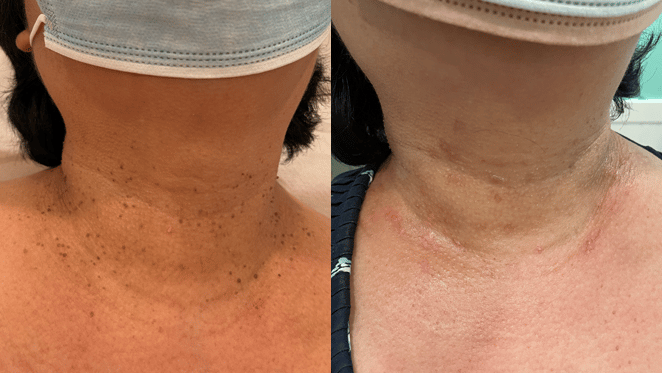Lesion & Mole Removal
Dr. Mona Khurana, the founder of Shine MD, has an aptitude for procedural medicine that served her greatly during her years of working in emergency medicine. Now, at Shine MD, she applies her extensive knowledge and skillful approach to performing lesion removals and a variety of other treatments. Dr. Khurana is thoughtful in her approach to various skin lesions and will have a detailed discussion with you regarding your treatment plan.
Book a lesion removal consultation at our Vancouver clinic.
Types of Skin Lesions
Skin Tags
Skin tags are small flaps of excess skin that can occur anywhere on the body. They can be of various sizes and are generally harmless. Patients often request the removal of skin tags for aesthetic purposes. Skin tags can also become irritated from friction or rubbing.
Moles
Moles can be of various colors and can occur anywhere on the body. While many moles are completely harmless, moles that change in color, size or shape may require medical intervention. Moles of concern should be assessed under magnification (dermoscopy) by your physician. If removed, moles can be sent to the lab for pathology for added reassurance and diagnostic certainty.
Seborrheic Keratoses
Seborrheic keratoses are commonly occurring spots on the skin that can be flat or raised and can be of various colors, typically brown, black, or tan. These lesions look waxy or scaly in texture, and sometimes have a wart-like appearance. Many people develop more seborrheic keratoses lesions as they get older.
Sebaceous Hyperplasia
Sebaceous hyperplasia is the enlargement of skin glands caused by trapped sebum. These are usually small, flesh-colored bumps on the skin that are harmless. However, patient’s may find sebaceous hyperplasia lesions to be aesthetically bothersome and choose to have them removed.
Learn More About Lesion & Mole Removal
The approach to removing skin lesions varies based on your preference and the nature of the skin lesion. Prior to removal, the area is injected with a local anesthetic called lidocaine to enable a painless procedure.
Many skin lesions can be removed with a sophisticated instrument called an Ellman Surgitron. This machine applies radiofrequency energy and coagulation to your skin to delicately shave the lesion away, causing less trauma to the skin than other methods. After your procedure, there will be a defect on your skin where the lesion was removed. It will take about 1-2 weeks for the area to create a complete scab. When the scab clears, there may be some redness to the area that should settle with time. Many patients use silicone gel sheets to improve healing and decrease redness.
Dr. Khurana is also skilled in the use of the Erbium laser machine, which can precisely vaporize tissue, improving the appearance of moles, skin tags, and sebaceous hyperplasia. Larger lesions are first removed with a shave excision and then refined with the Erbium laser. The healing from this treatment is usually uneventful and leaves the patient with minimal scarring.
Some moles may require surgical removal with a classic excisional technique and are closed with sutures. This method is especially important for the removal of moles that have features that are suspicious for skin cancer.
The recovery process after a skin lesion removal varies depending on the type of lesion, the size of the lesion, the removal technique, and your body’s natural healing process. After most skin lesion removals, the skin takes one to three weeks to heal. While the skin heals, there may be some swelling or redness in the area.
If you have had cosmetic lesion removal with electrosurgery or laser treatment, it is common for redness to remain in the area for many weeks after the treatment. After the initial healing period, improvement of redness can be accelerated with BroadBand Light laser spot treatment.
Wound remodeling continues for over one year after a skin lesion removal procedure and will continue to improve with time.
You may be a good candidate for skin lesion removal if you have a skin tag, mole, seborrheic keratoses, or sebaceous hyperplasia that you find aesthetically bothersome. You may also be a good candidate if you are concerned about the appearance of a skin lesion on your body, and believe it may require medical intervention.
If you are uncertain about your diagnosis, you can request a referral from a family physician for an assessment at our clinic. If your skin lesion has features worrisome for skin cancer, the biopsy and removal of some lesions can be a covered benefit of the Medical Services Plan of British Columbia. The Medical Services Plan of British Columbia does not provide coverage for lesions removed for aesthetic or cosmetic purposes.
Skin Lesion Removal Pre and Post Care Instructions
At Shine MD, your comfort and safety are our top priority. In order to ensure that you have the best experience possible, we have compiled a list of guidelines to follow before and after your treatment. Click on the button below to learn more.
Discover Our
Before & After Gallery
Want to see real patient results from our innovative skin treatments? View our impressive before and after images in our photo gallery.

*Individual results may vary.

